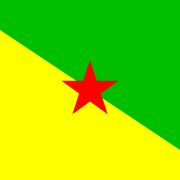
Unreliable Geographies by Aeneas McHaar
No. 6: Bellevue d’Ilinini, French Guiana
3° 35’ N, 53° 31’ W
Bellevue d’Ilinini is almost unimaginably different to Bellevue Crescent.
It emerges, if at all, from steaming tropical rainforest and is the highest mountain in French Guiana. At least, it may be. It is 2,792ft high, but other mist-drenched and as yet inaccurately measured mountains nearby may be taller. Indeed, there is a great deal still to be discovered or confirmed about French Guiana should it ever stop steaming long enough for French scientists to research.
Aside from its lack of a church, green and pleasant garden, art gallery, temperate climate, A-listed Georgian architecture and parking spaces, the principal distinguishing feature of Bellevue d’Ilinini is its wildlife: there are no grey squirrels.
The village and commune of Bellevue, situated below the mountain, are on the road to the only ever very vaguely situated and defined Saint-Laurent-du-Maroni. This is a place which defeats all efforts by tourism websites to list its accommodation and attractions, of which there are none by Western standards. No swimming pools, no restaurants, no en suite bidets; simply around 1,000 Amerindian Kali’nas watching cautiously as rare European visitors maunder on about irritating insects and the lack of facilities. The names of nearby settlements – Patience, Boeuf Mort, Dégrad, and Repentir – suggest that Europeans, French ones in particular, have been not enjoying themselves locally for some time.
France has had a presence in this corner of South America (squeezed between Suriname and Brazil) since the 17th century, and from the 1850s until 1939 used it for notoriously brutal prison colonies. Steve McQueen, Dustin Hoffman, Richard Dreyfuss and Wendy Craig brought the latter period vividly to life in Carla Lane’s harrowing Butterflies.
Since 1947 it has been an overseas French department, and from 1975 the ‘spaceport’ of the European Space Agency. Coastal Kourou, visible on a very clear day with a powerful telescope from the summit of an immense tree on Bellevue d’Ilinini, was chosen for this purpose because of its ease of access and the remarkable density of indigenous astrophysicists; not because anyone questioned the wisdom of blasting heavy objects into the atmosphere over France.
As in Bellevue Crescent, there is no obvious clamour for political change. Vast French subsidies to the local economy may partially have restricted the nationalist vote at the last election to a meagre 5 percent.